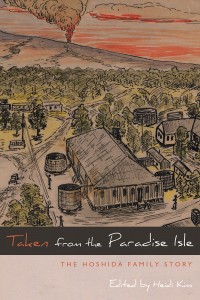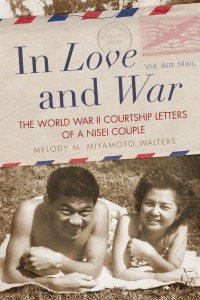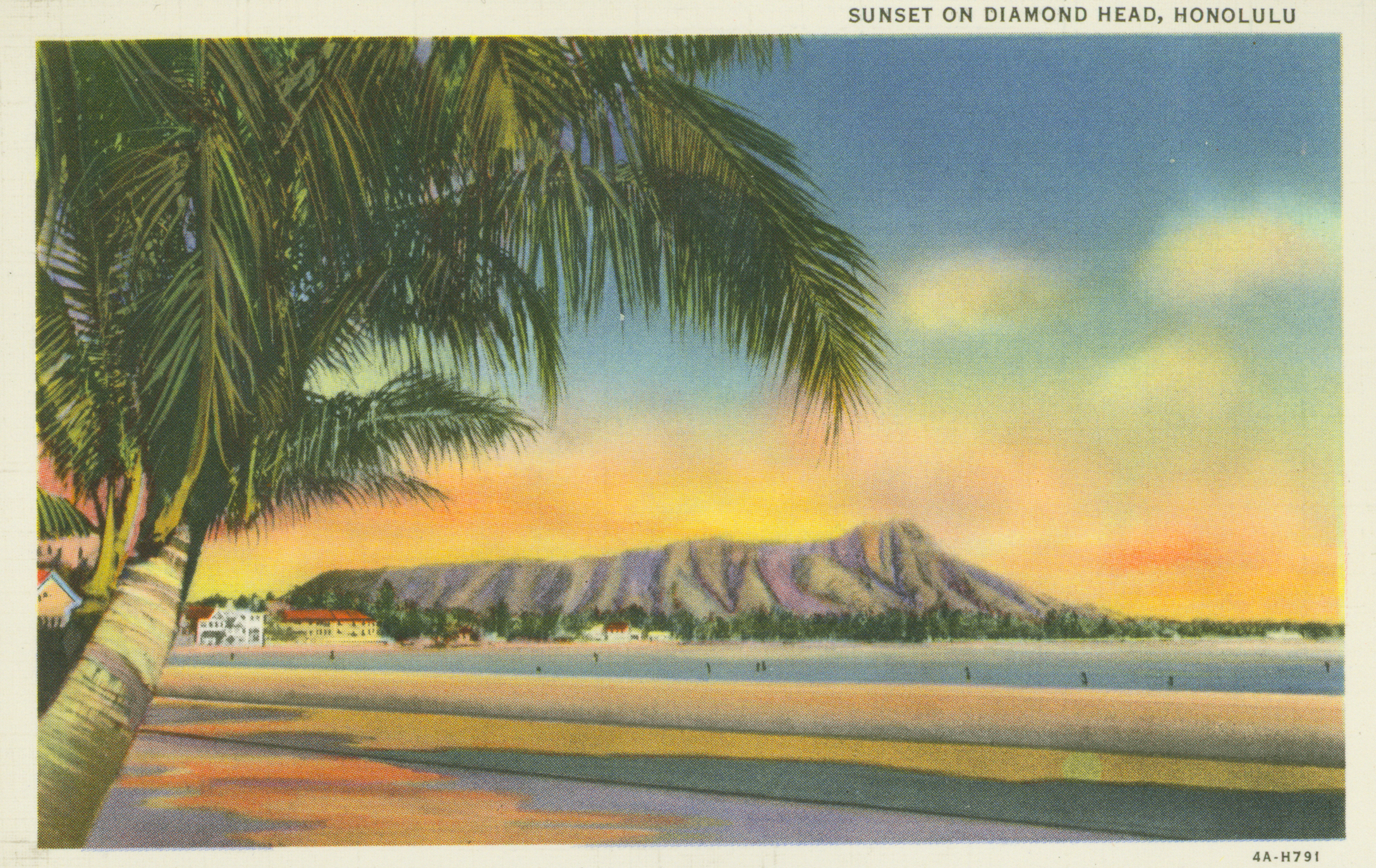January 26, 2016
A number of important works in recent years have started to close this gap, and the two present volumes add to the mix, telling very different wartime stories largely through the voices of the affected Japanese Americans themselves. One, Taken from the Paradise Isle: The Hoshida Family Story, is an internment story, crafted from the memoir of internee artist George Hoshida and from letters he and his wife Tamae exchanged during their wartime ordeal; the other, In Love and War: The World War II Courtship Letters of a Nisei Couple, is the story of a young Nisei couple’s courtship under martial law, built around the letters they exchanged over a two-year period prior to their wedding during which time they largely found themselves living and working on different islands. Both add to our knowledge of the Hawai’i experience and both are engaging reads.
[Cover Photo: UH Manoa: Hamilton Hawaiian Rare-Library, Aloha Hawaii Scrapbook]
 Taken from the Paradise Isle: The Hoshida Family Story adds to the suddenly crowded field of internment biographies/memoirs. Best know today as an artist whose drawings illuminate his internment, George Hoshida was born in Japan in 1907, but migrated to Hawai’i at the age of four and grew up as the son of a plantation laborer on the Big Island. Though a good student, he was forced to quit school after junior high in order to work to help support the family. After a stint at manual labor on a ranch, he turned to sales, eventually landing a job selling appliances for the Hilo Electric and Gas Company. He married a young Nisei woman named Tamae in 1933 and they had a daughter, Taeko, the following year. But soon after, Tamae and Taeko were involved in a serious car accident that left the daughter blind and brain damaged. Two more daughters followed in the years prior to the war. Active in his Buddhist temple, Hoshida also took up judo and eventually became an instructor.
Taken from the Paradise Isle: The Hoshida Family Story adds to the suddenly crowded field of internment biographies/memoirs. Best know today as an artist whose drawings illuminate his internment, George Hoshida was born in Japan in 1907, but migrated to Hawai’i at the age of four and grew up as the son of a plantation laborer on the Big Island. Though a good student, he was forced to quit school after junior high in order to work to help support the family. After a stint at manual labor on a ranch, he turned to sales, eventually landing a job selling appliances for the Hilo Electric and Gas Company. He married a young Nisei woman named Tamae in 1933 and they had a daughter, Taeko, the following year. But soon after, Tamae and Taeko were involved in a serious car accident that left the daughter blind and brain damaged. Two more daughters followed in the years prior to the war. Active in his Buddhist temple, Hoshida also took up judo and eventually became an instructor.
Two months after the attack on Pearl Harbor, George Hoshida was arrested. But unlike typical accounts of grim, dark suited FBI agents making the arrest, Hoshida was reluctantly taken into custody by his own brother-in-law, a local police officer. He was taken initially to Kilauea Military Camp, a detention camp on the Big Island. When his family was allowed to visit three weeks later, he learned that Tamae was pregnant.
As with other internees, Hoshida was given a hearing, in his case in Hilo. As was the case with most such hearings, the proceedings were stacked against the accused, who was not allowed to hear the evidence against him nor to challenge it. In Hoshida’s case the evidence was largely provided by an anonymous informant and can largely be described as guilt by association, as he was implicated for his apparent membership in a judo club that authorities viewed as subversive. Despite the efforts by Hoshida and a lawyer hired for him by his policeman brother-in-law to portray him as a local American—efforts stymied in part by the happenstance of his having been born in Japan and thus being prohibited from American citizenship by racist naturalization laws—the hearing board recommended his internment for the duration of the war.
The rest of the narrative follows his internment at various camps in the continental U.S. including Fort Sam Houston, Texas and Lordsburg and Santa Fe, New Mexico, along with Tamae and the family’s travails in Hilo, their own eventual internment in the Jerome, Arkasnas concentration camp, and their efforts to reunite. Editor Heidi Kim uses Hoshida’s own unpublished memoir, written in the 1970s, as the spine of the story, filling it in with letters between George and Tamae (and an occasional letter between George and another family member). The memoir itself draws on George’s diary entries from the time. Kim also adds George’s drawings and relevant documents to the mix.
Taken from the Paradise Isle most resembles two prior volumes in structure: Louis Fiset’s Imprisoned Apart: The World War II Correspondence of an Issei Couple (Seattle: University of Washington Press, 1997) and Family Torn Apart: The Internment Story of the Otokichi Muin Ozaki Family, edited by Gail Honda (Honolulu: Japanese Cultural Center of Hawai’i, 2012). Like Taken from the Paradise Isle, these earlier books tell family internment stories through the families’ own words in the form of letters, creative expression, and memoir, the former on a couple who had been in Seattle before the war, the latter about another Big Island family. One of the central dramas in each centers on the families’ often frustrating attempts to reunite, whether back home or in another internment camp.
Of the three, the present volume is the most enjoyable to read. This is due in large part to Hoshida’s own voice, ranging from the constrained (due to censorship) but affectionate letters to Tamae to the detailed, generally optimistic, but occasionally angry observations in his diary/memoir. George’s many drawings also enliven the proceedings. Kim wisely trims the memoir, sometimes dramatically, and keeps the letters to a reasonable but sufficient number, whereas the earlier two volumes include perhaps too much material for some readers. (Note: George Hoshida’s collection is at the Japanese American National Museum. Two hundred sixty drawings and watercolors are online and can be viewed at the JANM website.)

 In Love and War: The World War II Courtship Letters of a Nisei Couple fills a unique space in the historiography of Japanese Americans during World War II in that internment/incarceration is a mere footnote in the story of the romance between the poor Kaua’i farm boy Yoshiharu Ogata and the relatively well-off Honolulu city girl Naoko Tsukiyama. Author Melody M. Miyamoto Walters, the couple’s granddaughter, found the letters after Yoshiharu’s death in 2007 and fills in the gaps in the story through information gleaned from interviews, family memoirs and photo albums, and present-day comments from Naoko, still alive and well when Walters was doing her research.
In Love and War: The World War II Courtship Letters of a Nisei Couple fills a unique space in the historiography of Japanese Americans during World War II in that internment/incarceration is a mere footnote in the story of the romance between the poor Kaua’i farm boy Yoshiharu Ogata and the relatively well-off Honolulu city girl Naoko Tsukiyama. Author Melody M. Miyamoto Walters, the couple’s granddaughter, found the letters after Yoshiharu’s death in 2007 and fills in the gaps in the story through information gleaned from interviews, family memoirs and photo albums, and present-day comments from Naoko, still alive and well when Walters was doing her research.
The odd couple meets on O’ahu in 1941 through common friends at the YMCA. One of five children of a merchant family, Naoko (1917– ) was raised a Christian and, along with her siblings, was among the relatively few local Japanese kids to attend English standard schools. Upon her graduation from Roosevelt High School in 1936, she went on to the University of Hawai’i, graduating from the Teacher’s College in 1940 and obtaining her teacher’s certificate in 1941. In the summer of ’41, she did clerical work and hung out with friends at the Y while waiting for a teaching assignment for the fall. One of nine children of a plantation luna, Yoshiharu (1919–2007) was the only one to attend college, going to the Stout Institute in Wisconsin after his graduation from Waimea High School. After his graduation in December 1940, he landed a job as an industrial arts teacher in Honolulu and lived at the Nuuanu YMCA.
The correspondence began that summer when Yoshiharu returned home to Kaua’i for the summer, while Naoko remained in Honolulu and continued when she was assigned to an elementary school on the Big Island that fall. Over the next two years, the letters continued as the couple meet occasionally, but were mostly separated, with Yoshiharu shuttling between Kaua’i and O’ahu (he eventually ended up teaching at his alma mater, Waimea High) and Naoko between the Big Island and O’ahu.
The letters are charming. We immediately see the class and education gap, as Naoko’s letters are witty and grammatically impeccable, while Yoshiharu’s are much more colloquial and rough hewn, something he was well aware of and self-conscious about. In an early letter, he expressed admiration for her well-written letters and downplayed his qualifications as a suitor, while also making his interest known, in exactly the manner I would expect from a Nisei guy. “There are many swell and better fellows than I am,” he wrote on August 20, 1941. “I know you will meet them. When you do, I will envy him.”
It is fun to see the relationship develop. They were just friends at first, but their friendship deepened quickly, fueled perhaps by the uncertainly that the war and martial law brings. Yoshihiro proposed breaking it off in the spring of ’42 given that they there was a chance they would not see each other that summer due to wartime transportation issues, but they did reunite in Honolulu that summer and by the fall, each seemed to assume that they were headed down the path to marriage. They became engaged when they saw each other over the winter break at the end of 1942 and eventually marry in June of 1943. The letters provide a fascinating glimpse into gender roles and expectations of the time, and the principals negotiated with their families over both Japanese and Christian/Western wedding protocols and with each other over proper behavior both before and after marriage.
Through it all, the war and martial law looms in the background. Wartime transportation issues dogged the couple and help shaped the correspondence (by keeping them apart) and, hen Naoko had difficulty getting back to Honolulu, almost forcing them to postpone the wedding. The massive influx of soldiers and war workers dramatically altered the sex ratio on the islands and pressed young unmarried women like Naoko into service when providing female companionship to soldiers through dances and USO activity was framed as contributing to the war effort. Serving one’s country also came to the forefront for Yoshihiro, as he became involved in the Kauai Morale Committee and in an affiliated volunteer labor battalion called the Kiawe Corps. Contrary to the popular image of Nisei men in Hawai’i rushing to volunteer for the 442nd when given the opportunity, Yoshiharu was reluctant to do so and successfully obtained deferments to the draft. While he was not clear about the reason for his reluctance, Walters suggests that it had to do with familial obligations—he was the only son still at home and he helped support his family, whom he felt indebted to for financing his college education—and with his family being further removed from the majority society in contrast to Naoko’s family in Honolulu. In contrast, Naoko’s brother, Ted Tsukiyama famously became one of the founders of the Varsity Victory Volunteers and served in both the 442nd and the Military Intelligence Service and later became one of the most prominent chroniclers of that experience.
Such nuanced and seemingly conflicting views of “Americanism” also reveals itself in the Hoshida book. Though technically Issei, he had lived entirely in Hawai’i since age four and was more Nisei culturally. He was keenly aware of the injustice of his incarceration and its seeming violation of the US. Constitution as he had learned about it in school. At several points, he also expressed solidarity with African Americans and others who also suffered from discrimination in the U.S. His voice is unabashedly patriotic—he expressed his willingness to take arms against Japan if asked (albeit reluctantly). Even his brief flirtation with returning to Japan—a thought that Tamae angrily disabuses him of—seems to stem more out of anger out of his adopted country’s betrayal than any identification with the old country.
While both books are well edited, the Hoshida book could use more context, while the Ogata/Tsukiyama one might have too much. In the Hoshida book, little background is provided about the enemy alien detention program in general, and the reader is not told how typical or atypical this internment story was. While some of the included documents are interesting, no context is provided for them. We are not told about some of the key figures that appear in them such as Karl Bendetsen, and a transcript of Tamae’s Leave Clearance Hearing doesn’t explain the purpose of that hearing nor of the Japanese American Joint Board referred to in it. The memoir also ends abruptly with return of the family to Hawai’i. Though the introduction briefly fills in the rest of George’s (who died in 1985) and Tamae’s (who died in 1970) lives, it would have been nice to have had an additional chapter that includes reflections on internment and postwar life in their own voices, whether from letters, diaries, or George’s memoir.
Author and granddaughter Walters adds voluminous context and annotation to Yoshiharu and Naoko’s letters. While readers can ignore the many footnotes if they so desire, it is harder to skip her comments and introductions between sets of letters. While these interjections are informative, they also preview the main content and themes of the letters to come, acting somewhat like “spoilers.” Perhaps these sections were necessary to arrive at a book length manuscript, since there aren’t all that many letters, and for part of the time, only Yoshiharu’s letters were saved. An epilogue fills in the rest of their lives.
In addition to their other virtues, these stories are valuable for being different from what we are used to seeing. The young, patriotic Issei internee and the Nisei couple who are neither soldiers nor internees make for good reading and help broaden our understanding of the chaotic war years in Hawai’i.
—
By Brian Niiya, Densho Content Director
Summary: The books reviewed here mark worthwhile additions to the literature on Japanese Americans in Hawai’i during World War II. Taken from the Paradise Isle is an internment story based on a 1970s memoir and wartime letters, journal entries, and drawings while In Love and War is based on the love letters of Nisei couple in martial law Hawai’i over a two-year period. While both are expertly edited and would be enjoyable for both academic and lay audiences, there is perhaps not enough historical context in the first and too much in the second.
